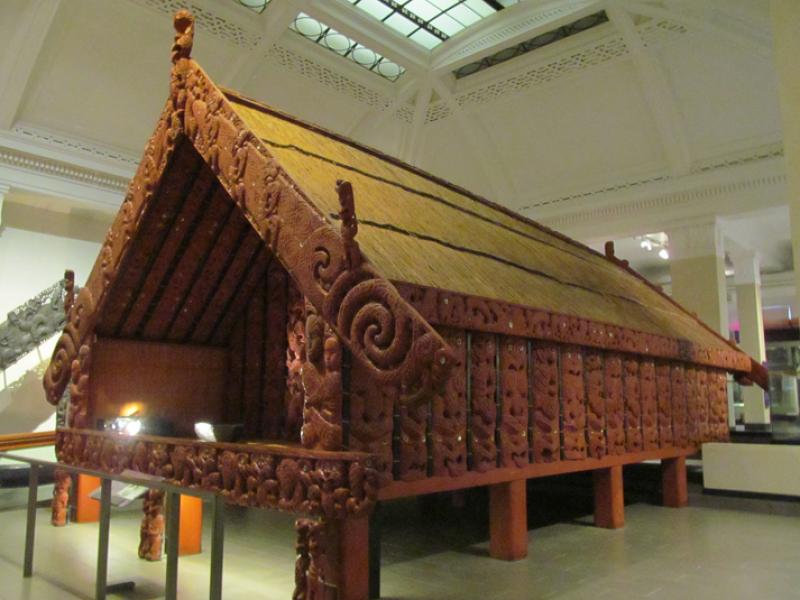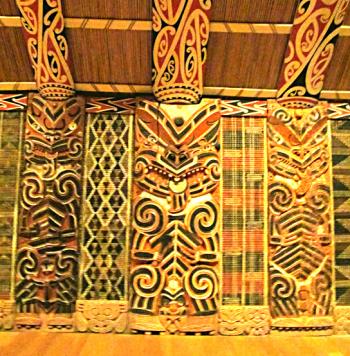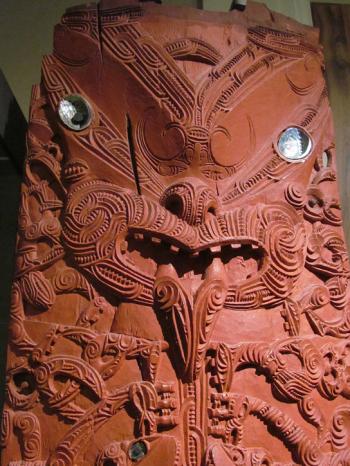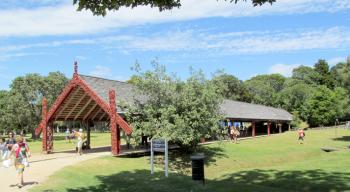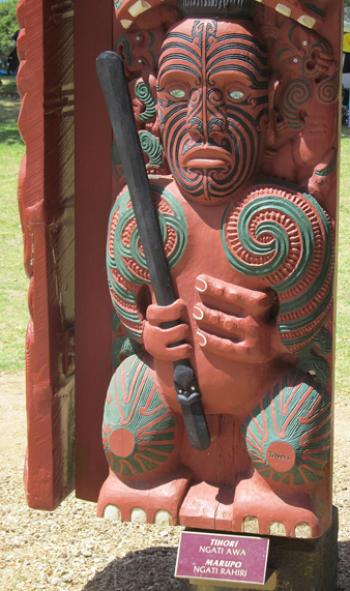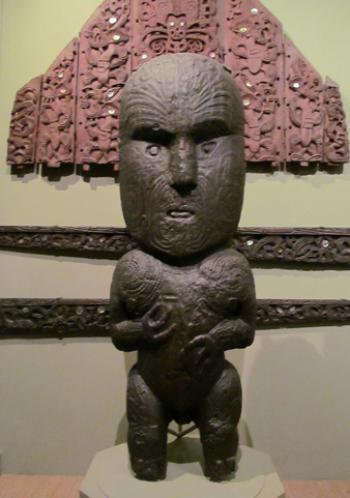The Māoris of Aotearoa (Second of two parts)
This item appears on page 23 of the November 2020 issue.
For three weeks in February 2020, my husband, Paul, and I explored much of New Zealand. Of the six areas we visited — Auckland, Bay of Islands, Queenstown, Franz Josef Glacier, Christchurch and Rotorua — Rotorua was easily our favorite (Oct. ’20, pg. 27).
This was primarily because of the richness of Māori culture found in and near this city located on North Island, one of the two major islands making up New Zealand (the other being South Island). As if Māori culture was not enough, there are also the spectacular displays of geothermal activity in the area immediately surrounding Rotorua.
Although Rotorua was special for us, there are other places in New Zealand where Māori culture can be sampled. We were fortunate to visit a few of those as well.
Auckland Museum
First and foremost among these other places is the Auckland War Memorial Museum, or Tāmaki Paenga Hira (phone 64 9 309 0443, aucklandmuseum.com), in New Zealand’s largest city (pop. 1,700,000).
Located in the Auckland Domain and surrounded by acres of greenery and with harbor views, this museum offers one of the best collections of Māori artifacts in the world. It is so extensive and spectacular that we visited three times during our nine days in Auckland.
Our focus on most of our visits was the Māori Courts. There are so many treasures there that it is difficult to pick out just a few highlights in the collection. But for those with limited time, here are five that should not be missed on even the shortest visit.
Auckland waka taua
First is the waka taua (war canoe) called Te Toki a Tāpiri, which dominates much of the Māori central court. Carved in about 1836 from a single totara log and covered with intricate carvings, this 81-foot-long canoe was capable of holding at least 100 warriors.
Although designed as a war vessel, it is a thing of beauty as well, one that museum visitors can admire close up.
Also dominant in the huge Māori Courts are two structures standing at angles to each other. Te Puawai o te Arawa pātaka is a raised storehouse once used to protect food and to store weapons and tools. It was commissioned for a Māori chief, Te Pokiha, in the 1870s and once stood on the coast of the Bay of Plenty, southeast of Auckland.
The pātaka’s open front porch, rafters and side panels are filled with extraordinary carvings, including pairs of surprised-looking lovers on the front corner panels and bird-like creatures with pāua-shell eyes filling the rafters.
Beside the pātaka stands the hoto nui, or meeting house, also from the Bay of Plenty. A front porch leads into a large room filled with carvings on both walls and on roof rafters. Visitors are invited inside, but shoes must be left outside the porch out of respect.
Paintings of Māoris
Not many steps from the meeting house are some of the extraordinary Māori portraits painted by Gottfried Lindauer (1839-1926), born in what is now the Czech Republic, and by Charles Frederick Goldie (1870-1947), an Auckland native. The paintings depict a handsome, dignified-looking people wearing their traditional Māori clothing, in some cases with facial tattoos.
Another not-to-be-missed piece is the Tangonge Lintel, considered one of the earliest Māori carvings in the world. Carved of totara wood, it was found in 1920 when Lake Tangonge in the far north of North Island was drained.
The Tangonge Lintel was probably once placed above a doorway and has been dated to possibly as early as the 1400s, in the early days of the Māoris’ arrival in New Zealand from central Polynesia.
In addition, there are wonderful woodcarvings on the walls of the Māori Courts as well as hundreds of items displayed in glass cases.
Pacific collection
On the same floor as the Māori Courts are rooms devoted to Pacific Islanders, the peoples inhabiting other islands of the vast Pacific Ocean, including Samoa, Tonga, Fiji, the Cook Islands and a host of others.
Over 200,000 Pacific Islanders live in Auckland alone, which has the distinction of being the largest Polynesian city in the world if you go by the ethnic origins of its population. So it is fitting that the Auckland Museum should have sections dedicated to Pacific Islanders.
Among artifacts on display are Micronesian masks, a Fijian drua, or fishing canoe, and life-size Papua New Guinea wooden carvings.
The museum also features a Māori natural history section, a volcanoes section (with realistic simulations of an erupting volcano) and an entire level dedicated to New Zealand’s involvement in wars of the past 180 years.
The Auckland Museum is open daily from 10 to 5. The admission charge for international visitors is NZD28 (near $18). At additional charges, collection highlights tours are offered four times each day and cultural performances, three times each day.
Waitangi
The Bay of Islands, appropriately named, is a large bay dotted with more than 140 islands 145 miles northwest of Auckland. People visit not only for its physical beauty but for its historic importance.
It was there in what is now the Waitangi Treaty Grounds (phone +64 9 402 7437, waitangi.org.nz) that the Treaty of Waitangi was signed on Feb. 6, 1840. Waitangi is regarded in New Zealand as the birthplace of the nation, and the treaty is considered the country’s founding document.
The treaty signed by the first 43 Māori chiefs (eventually a total of more than 500 signed) and by Captain William Hobson, representing the British government, defined the relationship between the Māori and the Pākehā, as the Europeans were called. It became the basis for Britain’s claim to New Zealand as another colony to add to the British Empire.
February 6th is now celebrated as a public holiday in New Zealand. We visited the Waitangi Treaty Grounds on the day before, when preparations were under way for the following day’s official ceremonies, when dignitaries arrived to commemorate the events of 180 years ago.
There are several outstanding Māori structures to visit and one historic Pākehā building as well.
Waitangi waka taua
An immense whare waka (boathouse) shelters one of the largest ceremonial waka taua in existence, though on the day we visited, it was out on the water nearby for a practice run, we were told, in preparation for the following day.
We had an idea of what we were missing, having seen the enormous war canoe in the Auckland Museum just a few days before, but the boathouse itself is well worth seeing, with its intricate carvings and impressive size, built to shelter the 115-foot-long canoe.
A short stroll takes visitors to Te Whare Rūnanga, the Māori meeting house. Opened in 1940 for the centennial of the Treaty of Waitangi, the meeting house’s carvings of red-painted wood depict the ancestors of many of today’s Māori tribes. There are also carvings inside, interspersed with intricately worked reed latticework called tukutuku.
It is in this meeting house that cultural performances are usually offered three times each day.
Treaty House
The Waitangi Treaty House, a simple white cottage, is one of New Zealand’s oldest buildings. It was shipped in pieces from Australia and reassembled to become the home of the official British Resident, James Busby, a representative of the British government in New Zealand from 1833 to 1840. Busby helped draft the Treaty of Waitangi.
Although tradition says that the treaty was signed inside the house, our guide told us that the signing actually took place on the lawn in front of the house, where a flagpole marks the spot.
The Waitangi Treaty House is open 9 to 6, from Dec. 26 to Feb. 28, during New Zealand’s summertime. The rest of the year it’s open from 9 to 5. Admission is NZD50 ($33).
Christchurch
The Māori collection in Canterbury Museum in Christchurch on the South Island came as a surprise.
Christchurch suffered two powerful earthquakes practically back to back, in September 2010 and February 2011. A majority of the city’s buildings were either damaged or destroyed in the catastrophes, and 185 people lost their lives in the 2011 quake.
Today, it is a city in reconstruction and revival. Paul and I wanted to visit the spectacular Christchurch Botanic Gardens, which I vividly remembered from my previous trip. Most of the trees, some planted 150 years ago, survived the earthquakes.
Because the gardens are so extensive, we opted to take the “Gardens Tour,” which cost NZD20 ($13) aboard the “caterpillar,” a small electric train that wends its way through 74 acres of parkland.
Canterbury Museum
We arrived an hour too early for the tour and decided to pop inside the Canterbury Museum (phone +64 3 366 5000, canterburymuseum.com), located right beside the entrance gate to the Botanic Gardens.
Good thing we did. The museum exhibits Māori artifacts among its numerous other collections, including a reconstruction of a pre-European-contact Māori home, woodcarvings and pendants made of pounama, greenstone.
Pendants carved in the shape of human figures, sometimes grotesque or distorted, are called tiki and are still worn by Māori as personal adornment but are also considered imbued with symbolic power.
The Canterbury is open 9 to 5 from April to September, 9 to 5:30 from October to March. There is no admission charge, but donations are welcomed.
Special places
Special as were the Māori sites/sights we visited in Rotorua, Auckland, Bay of Islands and Christchurch, there was so much else to see and do in New Zealand.
Some of our favorites — the Skyline gondola ride in Queenstown up to the Stratosfare Restaurant, where we enjoyed one of the best buffet lunches we’ve ever had, with views to match; the day excursion to Doubtful Sound (Milford Sound, our first choice, was closed to visitors because torrential rains had destroyed access roads just days before our arrival); the revolving restaurant, Orbit, atop Auckland’s 1,076-foot-tall Sky Tower, for the city views; the “Cardboard Cathedral” in Christchurch (temporarily replacing Christchurch’s Anglican cathedral, destroyed in the earthquakes), so named because it incorporates 98 huge cardboard tubes in its construction; dinner aboard a restored tram in Christchurch as it tools around the city while diners enjoy a gourmet dinner served with New Zealand wines, and, of course, attending at least one Māori cultural performance and one hangi, the latter where food is cooked on heated rocks in an earth pit — a unique and tasty experience.
If you go…
In Auckland, we stayed for nine nights at the Adina Apartment Hotel Auckland Britomart (+64 9 393 8200, adinahotels.com/en/apart ments/auckland-britomart), located at 2 Tapora Street in the city’s Central Business District, or CBD.
It offers studio, 1- and 2-bedroom apartments, with amenities like a washer and dryer in each unit, dishwashers, full kitchens and spacious layouts. There’s a café on site offering breakfast, lunch and dinner.
The cost of our 9-night stay was $2,458 (about $273 per night) for a 2-bedroom apartment.
Of the other six hotels and B&Bs we stayed in, the two we thought most special were Fiordland Lodge in Te Anau (fiordlandlodge.co.nz), an elegant timber lodge in a picturesque location, offering white-glove dinner service and gourmet meals, and, in Christchurch, Eliza’s Manor Boutique Hotel (elizas.co.nz), a Tudor-style B&B built in 1861 that was full of old-fashioned charm and lovely wood-paneled rooms, offering a great breakfast as well.
In the last issue, I mentioned the company Aspire Down Under (New York, NY; 877/727-7473 or 212/850-0946, aspiredownunder.com), which planned most of our 21-day trip to New Zealand, excluding Auckland, which we preferred relatively unplanned.
I cannot praise Aspire Down Under enough, especially the agent we worked with, Joanne Morgan, for putting together an itinerary that specifically suited our interests, time and pocketbook. A job well done!

